MSI GP66 Leopard review – extreme performance and a very swift 144Hz display
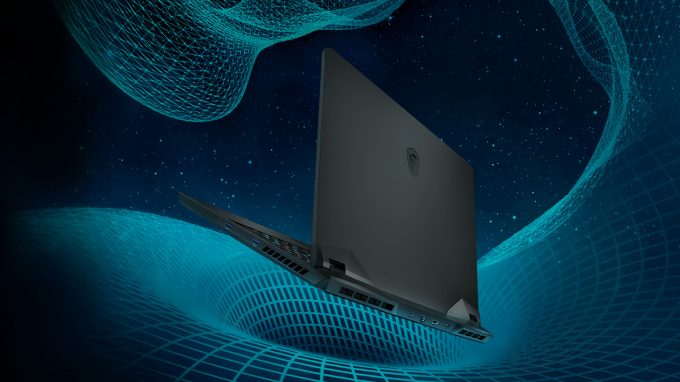 If you remember last year’s GP65 Leopard, you will know that it had a fairly decent design, which was a mix of classy and aggressive features. It is safe to say that in this regard, the new GP66 Leopard from MSI, is pretty similar. However, it has faced a complete visual overhaul, and it is now a lot thinner and looks more industrial than ever before.
If you remember last year’s GP65 Leopard, you will know that it had a fairly decent design, which was a mix of classy and aggressive features. It is safe to say that in this regard, the new GP66 Leopard from MSI, is pretty similar. However, it has faced a complete visual overhaul, and it is now a lot thinner and looks more industrial than ever before.
Since this is a gaming notebook, MSI didn’t want to experiment with the not-yet-proven AMD Zen 3 laptop processors. So, they chose the Comet Lake-H CPUs of Intel, built on the evergreen 14nm architecture. Indeed, they were not the most efficient, nor the best for CPU-intensive loads. However, they do best in one particular scenario – gaming.
Probably, it is the only architecture yet, that can take full advantage of the new RTX 3000 graphics cards, which can pump a lot of fps in slightly lower settings. This is great because the laptop comes with a 144Hz IPS display. And as we know, some users prefer less visual fidelity, but a more fluid and smooth image. Speaking of the GPU-s this device can be found with RTX 3060, RTX 3070, as well as the RTX 3080, although we are not sure about the TGP configuration of the latter.
You can check the prices and configurations in our Specs System: https://laptopmedia.com/series/msi-gp66-leopard/
Contents
Specs Sheet
- HDD/SSD
- 以至于 1000GB SSD
- M.2 槽
- 2x 2280 PCIe NVMe 3.0 x4
- 内存
- up to 32GB
- 操作系统
- Windows 10 Home, No OS, Windows 10 Pro
- 蓄电池
- 65Wh, 4-cell , 65Wh, 4-cell
- 车身材料
- Plastic / Polycarbonate, Aluminum
- 外形尺寸
- 358 x 267 x 23.4 mm (14.09" x 10.51" x 0.92")
- 重量
- 2.38 kg (5.2 lbs)
- 端口和连接性
- 1x USB Type-C
- 3.2 Gen 2 (10 Gbps), DisplayPort
- 3x USB Type-A
- 3.2 Gen 1 (5 Gbps)
- HDMI
- 2.0
- Wi-Fi
- 802.11ax
- 蓝牙
- 5.1
- 音频插孔
- 3.5mm Combo Jack
- 特点
- 指纹识别器
- 网络摄像机
- HD
- 背光键盘
- optional
- 扬声器
- 2x 2W, Nahimic 3
- 光驱
- 安全锁槽
全部 MSI GP66 Leopard (10UHx / 10UGx / 10UEx) 配置
What’s in the box?
Inside the package, you will find some paper manuals, a 230W charging brick, and the GP66 Leopard, itself.
Design and construction
As we said, the GP66 Leopard has shaved some of its profile and is now 4mm thinner than its predecessor – 23.4mm vs 27.5mm. However, it has gained some weight – 2.38 kg vs 2.30 kg, but we hope that this is all muscle and not fat. Moreover, the new laptop looks completely different, and instead of the Sci-Fi look of the older unit, we now get something more reminiscent of an Italian automobile maker, previously known for building tractors.
Additionally, the material on the lid and the base feels like metal, but we are not really sure. However, the bottom panel, the backside, and the hinges covers are definitely plastic. Speaking of the last, they look interesting, and to some, it may look too much, but we personally feel that it makes the transition from the sporty back to the neutral lid a bit smoother.
Also, the lid opens easily with a single hand, exactly as promised by MSI. While its side bezels are thin, we feel that the top, and especially the bottom one are a bit large. On the bright side, unlike some of its direct competitors from ASUS, this laptop comes with a Webcam.
So, we have come to the keyboard. Not only does it not include a NumberPad segment but it is now inferior to its predecessor, in our opinion. Sadly, the not very clicky mechanism and the relatively short key travel for a gaming device don’t feel very comfortable for either playing games or typing. Users here get some consolation from the per-key RGB backlight, and the function keys shortcuts, which launch the Dragon Center and Steelseries software and can push the fans to their maximum level at any time given.
As for the touchpad, it is a decent unit with smooth gliding and relatively accurate tracking. Gone are the dedicated buttons, however, which may disturb some of the gamers out there. Indeed we doubt that people would be playing games with the touchpad, instead of a dedicated mouse, but we’ve heard complaints before when manufacturers removed the dedicated buttons from their touchpads.
Another change here is the location of the speakers. Instead of firing downwards, now they are doing so sideways. As far as the bottom panel, there are some ventilation grills – two beneath the fans, and one beneath the CPU and the GPU heat pipes. Hot air, respectively, exits the notebook from the two slots at the back, and one on each side of the laptop.
Ports
On the back of this notebook, you will find the charging plug, an HDMI connector, an RJ-45 connector, and a USB Type-C 3.2 (Gen. 2) port with DisplayPort capabilities. Additionally, there are some ports on the sides as well. They include one USB Type-A 3.2 (Gen. 1) port, and an audio jack on the left, and two USB Type-A 3.2 (Gen. 1) ports on the right.
Display quality
MSI GP66 Leopard has a 144 Hz Full HD panel – LG LP156WFG-SPB3 (LGD0625). Its diagonal is 15.6″ (39.62 cm), and the resolution 1920 х 1080 pixels. The screen ratio is 16:9, and we are looking at a pixel density of – 142 ppi, and a pitch of 0.18 х 0.18 mm. The screen turns into Retina when viewed at distance equal to or greater than 60cm (24″) (from this distance one’s eye stops differentiating the separate pixels, and it is normal for looking at a laptop).
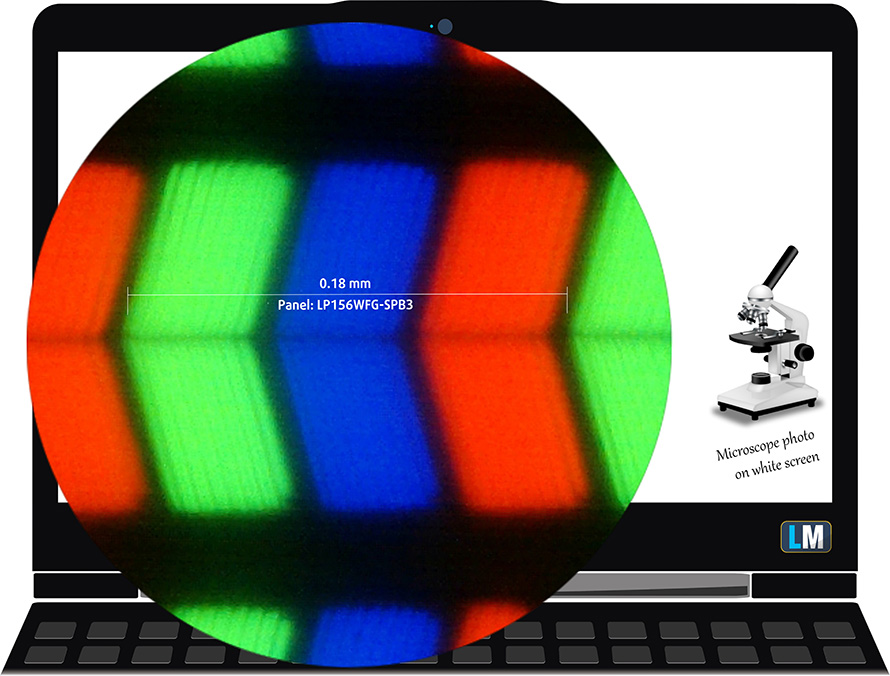
Viewing angles are excellent. We offer images at 45° to evaluate image quality.

They measured a reasonably high maximum brightness of 382 nits in the middle of the screen and 351 nits as an average for the whole area, with a maximum deviation of 14%. The Correlated Color Temperature on a white screen is 7100K – colder the optimal for the sRGB standard of 6500K.
In the illustration below you can see how the display performs from a uniformity perspective. In other words, the leakage of light from the light source.
Values of dE2000 over 4.0 should not occur, and this parameter is one of the first you should check if you intend to use the laptop for color-sensitive work. The contrast ratio is decent – 890:1.
To make sure we are on the same page, we would like to give you a little introduction to the sRGB color gamut and the Adobe RGB. To start, there’s the CIE 1976 Uniform Chromaticity Diagram that represents the visible specter of colors by the human eye, giving you a better perception of the color gamut coverage and the color accuracy.
Inside the black triangle, you will see the standard color gamut (sRGB) that is being used by millions of people on HDTV and on the web. As for the Adobe RGB, this is used in professional cameras, monitors, etc for printing. Basically, colors inside the black triangle are used by everyone and this is the essential part of the color quality and color accuracy of a mainstream notebook.
Still, we’ve included other color spaces like the famous DCI-P3 standard used by movie studios, as well as the digital UHD Rec.2020 standard. Rec.2020, however, is still a thing of the future and it’s difficult for today’s displays to cover that well. We’ve also included the so-called Michael Pointer gamut, or Pointer’s gamut, which represents the colors that naturally occur around us every day.
The yellow dotted line shows MSI GP66 Leopard’s color gamut coverage.
Its display covers 95% of the sRGB/ITU-R BT.709 (web/HDTV standard) in CIE1976.
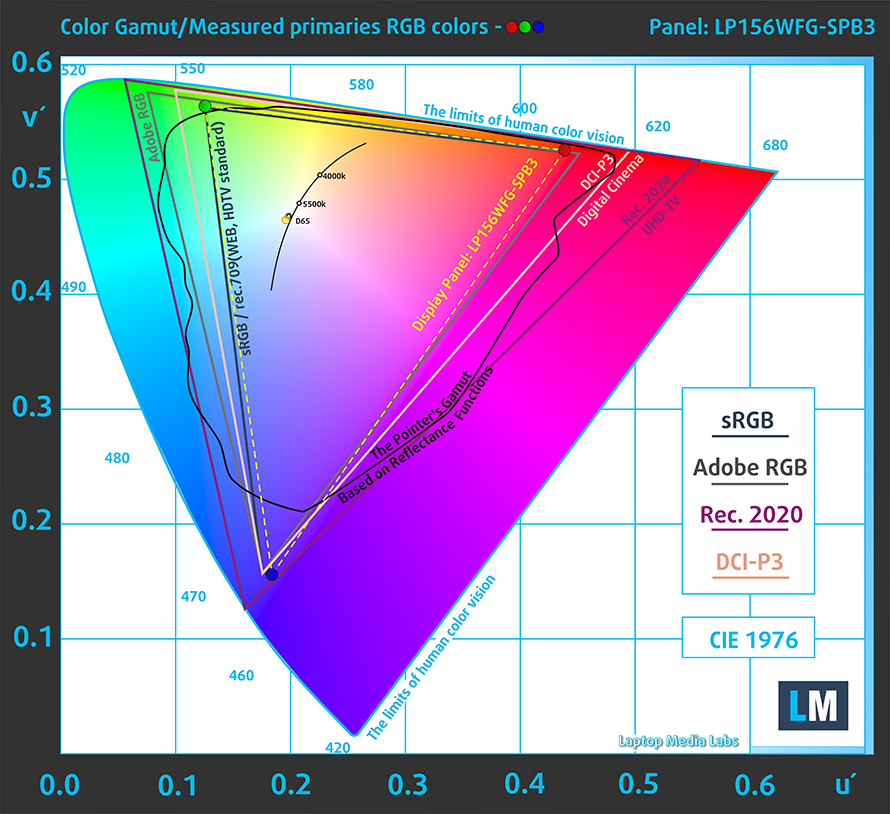
Our “Design and Gaming” profile delivers optimal color temperature (6500K) at 140 cd/m2 luminance and sRGB gamma mode.
We tested the accuracy of the display with 24 commonly used colors like light and dark human skin, blue sky, green grass, orange, etc. You can check out the results at factory condition and also, with the “Design and Gaming” profile.
Below you can compare the scores of MSI GP66 Leopard with the default settings (left), and with the “Gaming and Web design” profile (right).
The next figure shows how well the display is able to reproduce really dark parts of an image, which is essential when watching movies or playing games in low ambient light.
The left side of the image represents the display with stock settings, while the right one is with the “Gaming and Web Design” profile activated. On the horizontal axis, you will find the grayscale, and on the vertical axis – the luminance of the display. On the two graphs below you can easily check for yourself how your display handles the darkest nuances but keep in mind that this also depends on the settings of your current display, the calibration, the viewing angle, and the surrounding light conditions.
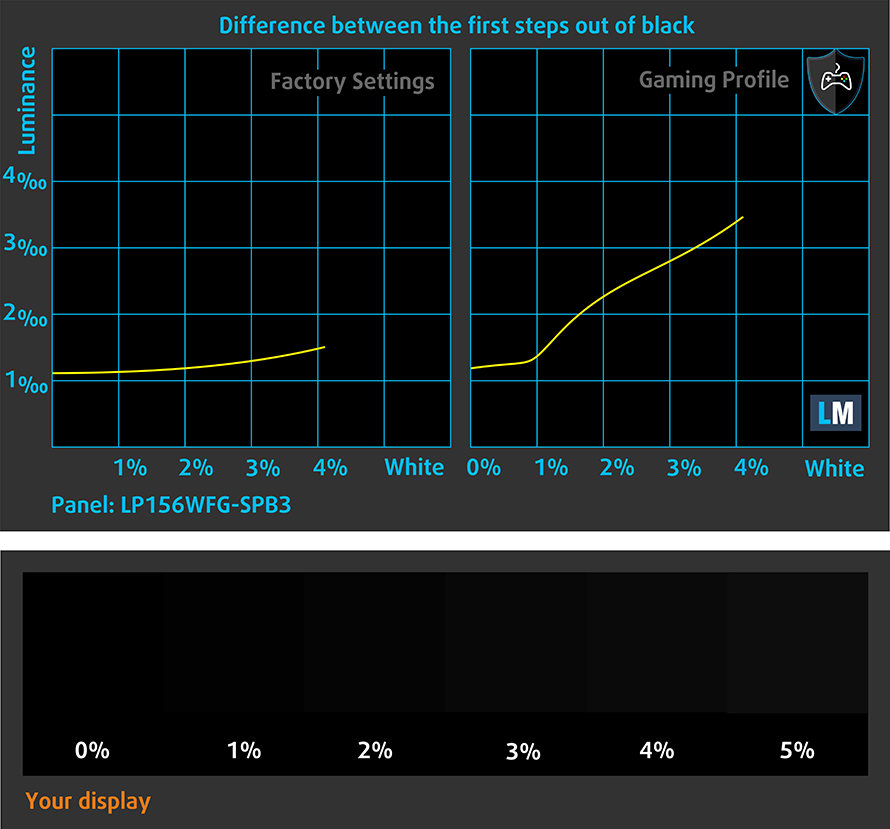
Response time (Gaming capabilities)
We test the reaction time of the pixels with the usual “black-to-white” and “white-to-black” method from 10% to 90% and vice versa.
We recorded Fall Time + Rise Time = 10 ms.
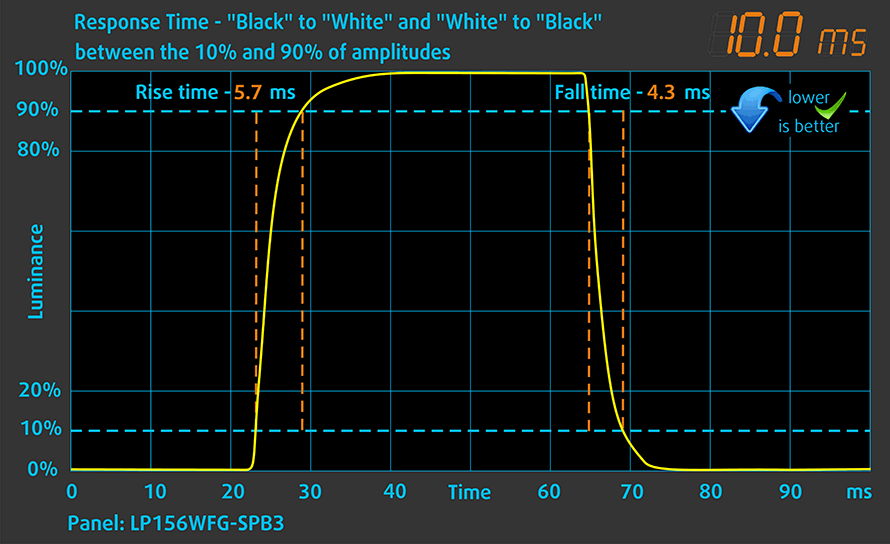
After that, we test the reaction time of the pixels with the usual “Gray-to-Gray” method from 50% White to 80% White and vice versa between 10% and 90% of the amplitude.
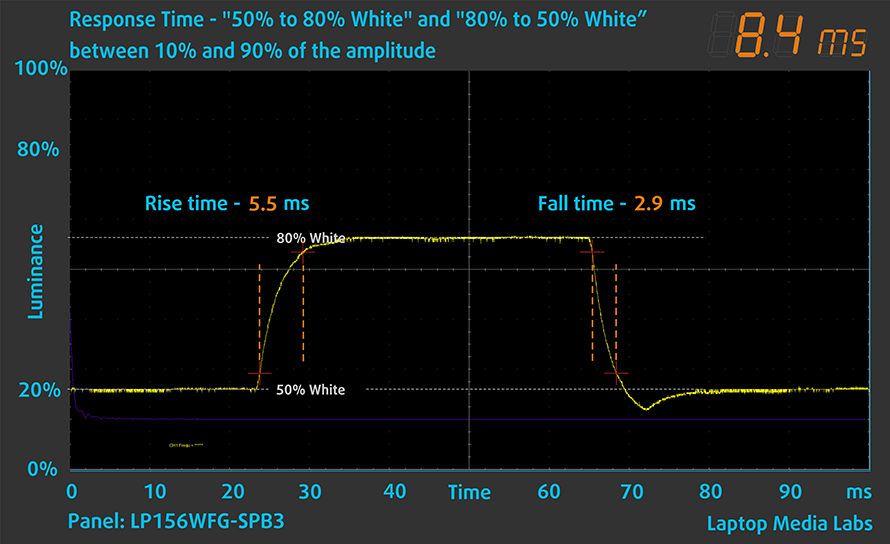
PWM (Screen flickering)
Pulse-width modulation (PWM) is an easy way to control monitor brightness. When you lower the brightness, the light intensity of the backlight is not lowered, but instead turned off and on by the electronics with a frequency indistinguishable to the human eye. In these light impulses, the light/no-light time ratio varies, while brightness remains unchanged, which is harmful to your eyes. You can read more about that in our dedicated article on PWM.
The display of MSI GP66 Leopard doesn’t use PWM to adjust its brightness at any point. This means it is comfortable for long gaming sessions without harming your eyes in this aspect.
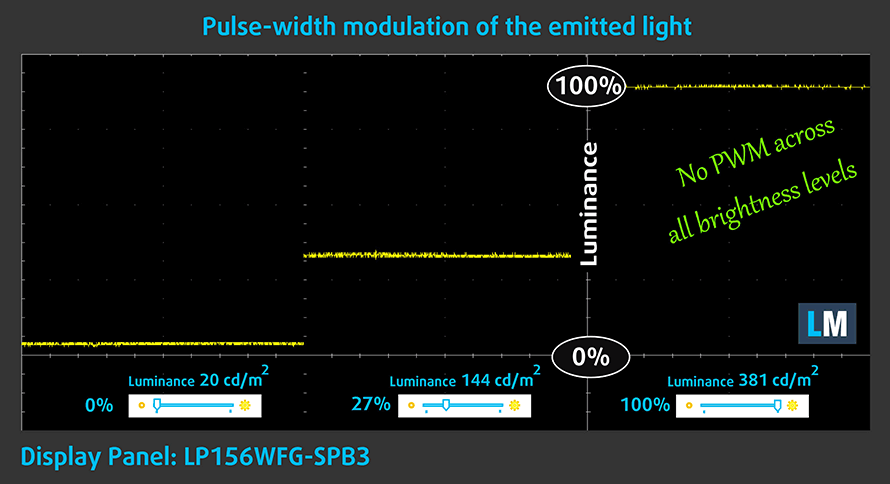
Blue light emissions
Installing our Health-Guard profile not only eliminates PWM but also reduces the harmful Blue Light emissions while keeping the colors of the screen perceptually accurate. If you’re not familiar with the Blue light, the TL;DR version is – emissions that negatively affect your eyes, skin, and your whole body. You can find more information about that in our dedicated article on Blue Light.
Conclusion
MSI GP66 Leopard’s 144Hz IPS panel is the same we found on the GP65 from last year. It has a Full HD resolution, pretty high maximum brightness, and comfortable viewing angles. Moreover, it covers 95% of the sRGB color gamut, and its backlight doesn’t flicker at any brightness level. Interestingly, this unit, combined with our Gaming and Web design profile delivers a very accurate color representation, which is great for professionals like designers, artists, and photographers. Unfortunately, we found an uneven uniformity of the luminance across the display, which is not ideal for the aforementioned. However, as you know, this is a gaming laptop, and its 144Hz refresh rate is combined with a very fast pixel response time, which ensures a smooth gaming experience.
Buy our profiles
Since our profiles are tailored for each individual display model, this article and its respective profile package are meant for MSI GP66 Leopard configurations with 15.6″ FHD IPS LG LP156WFG-SPB3 (LGD0625).
*Should you have problems with downloading the purchased file, try using a different browser to open the link you’ll receive via e-mail. If the download target is a .php file instead of an archive, change the file extension to .zip or contact us at [email protected].
Read more about the profiles HERE.
除了获得高效和健康友好的配置文件,购买LaptopMedia的产品,您还可以支持我们实验室的发展,我们在实验室测试设备,以产生最客观的评论。

办公室工作
Office Work应该主要由那些花大部分时间看文本、表格或仅仅是浏览的用户使用。该配置文件旨在通过保持平坦的伽玛曲线(2.20)、本机色温和精确的色彩来提供更好的清晰度。

设计与游戏
本资料针对专业处理色彩的设计师,以及游戏和电影。设计与游戏》将显示面板发挥到了极致,使其在白点D65的网页和高清电视的sRGB IEC61966-2-1标准中尽可能准确。

以33%的折扣获得所有3份资料
Sound
MSI GP66 Leopard’s speakers produce a sound of relatively good quality. However, its volume is a bit low, and the low, mid, and high tones all have some deviations from clarity.
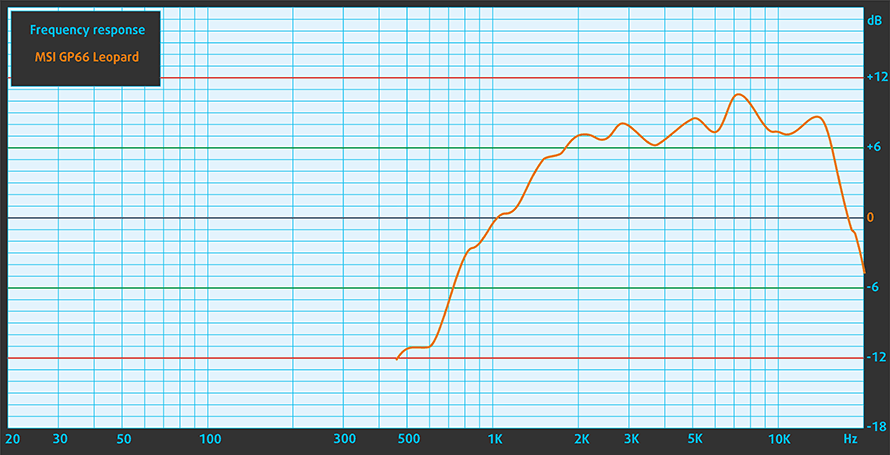
Drivers
Even if you get this laptop without a preinstalled OS, you get a partition on the SSD, that packs all of the drivers and utilities. Alternatively, you can download the latest versions from here: https://www.msi.com/Laptop/support/GP66-Leopard-10UX
Battery
Now, we conduct the battery tests with Windows Better performance setting turned on, screen brightness adjusted to 120 nits, and all other programs turned off except for the one we are testing the notebook with. This laptop’s 65Wh battery lasts for 4 hours and 23 minutes of Web browsing, and 4 hours and 54 minutes of video playback.
为了模拟真实情况,我们使用自己的脚本自动浏览了70多个网站。
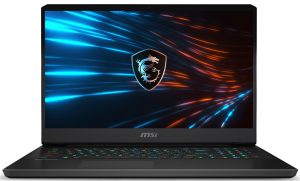
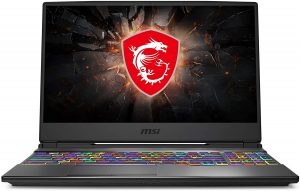
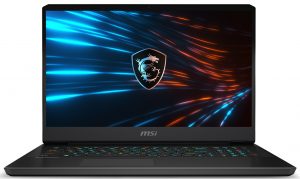
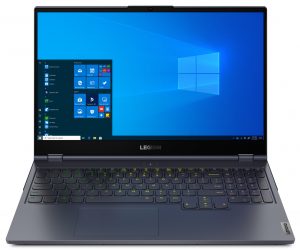
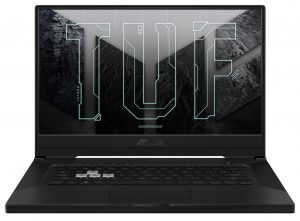
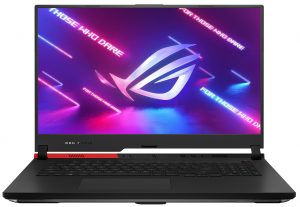
对于这样的每一次测试,我们都使用相同的高清视频。






CPU options
You have three choices, regarding the CPU of this notebook. The base one is the six-core Core i7-10750H, then come the two eight-core Core i7-10870H and Core i7-10875H.
GPU options
In terms of graphics, we get a very potent selection, including the RTX 3060 (6GB GDDR6), RTX 3070 (8GB GDDR6), and the RTX 3080 (8GB GDDR6).
结果来自3DMark:Time Spy(图形)基准测试(分数越高越好)。
结果来自3DMark:Fire Strike(图形)基准测试(分数越高越好)。
结果来自Unigine叠加基准(分数越高越好)。
Gaming tests

| Far Cry 5 | Full HD, Normal (Check settings) | Full HD, High (Check settings) | Full HD, Ultra (Check settings) |
|---|---|---|---|
| Average | 132 fps | 124 fps | 117 fps |

| Rise of the Tomb Raider (2016) | Full HD, Medium (Check settings) | Full HD, Very High (Check settings) | Full HD, MAX (Check settings) |
|---|---|---|---|
| Average | 162 fps | 96 fps | 65 fps |

| Tom Clancy’s Ghost Recon Wildlands | Full HD, High (Check settings) | Full HD, Very High (Check settings) | Full HD, Ultra (Check settings) |
|---|---|---|---|
| Average | 105 fps | 92 fps | 60 fps |

| Shadow of the Tomb Raider (2018) | Full HD, Medium (Check settings) | Full HD, High (Check settings) | Full HD, Highest (Check settings) |
|---|---|---|---|
| Average | 123 fps | 118 fps | 79 fps |
Temperatures and comfort
Max CPU load
In this test we use 100% on the CPU cores, monitoring their frequencies and chip temperature. The first column shows a computer’s reaction to a short load (2-10 seconds), the second column simulates a serious task (between 15 and 30 seconds), and the third column is a good indicator of how good the laptop is for long loads such as video rendering.
Average core frequency (base frequency + X); CPU temp.
| Intel Core i7-10870H (45W TDP) | 0:02 – 0:10 sec | 0:15 – 0:30 sec | 10:00 – 15:00 min |
|---|---|---|---|
| MSI GP66 Leopard (High Performance) | 3.49 GHz (B+59%) @ 95°C @ 85W | 3.34 GHz (B+52%) @ 95°C @ 76W | 3.24 GHz (B+47%) @ 93°C @ 70W |
| MSI GP76 Leopard (High Performance) | 3.67 GHz (B+67%) @ 95°C @ 103W | 3.53 GHz (B+60%) @ 95°C @ 94W | 3.33 GHz (B+51%) @ 90°C @ 80W |
As expected, the GP66 Leopard maintains slightly lower frequencies and a slightly lower power limit than its bigger sibling. Yet, it still runs 3° warmer at the end. If you don’t want all the power, you can choose a more lenient preset, and you will get a lot lower temperatures.
Real-life gaming
| NVIDIA GeForce RTX 3060 | GPU frequency/ Core temp (after 2 min) | GPU frequency/ Core temp (after 30 min) | GPU frequency/ Core temp (Max Fan) |
|---|---|---|---|
| MSI GP66 Leopard | 1863 MHz @ 72°C @ 124W | 1852 MHz @ 75°C @ 125W | 1849 MHz @ 69°C @ 127W |
| MSI GP76 Leopard | 1860 MHz @ 71°C @ 129W | 1857 MHz @ 73°C @ 128W | 1869 MHz @ 67°C @ 128W |
In a similar fashion, the RTX 3060 ran a bit warmer with relatively similar frequencies. Interestingly, the TGP of this unit was a couple of watts lower, which is puzzling, considering the better in-game performance we extracted from it.
Comfort during full load
And on the outside, we got a pretty reasonable temperature, so you won’t be exposed to high temperatures. Well, the sound level was a bit too high, not to mention that the Max-Fan mode would outscream a jet engine.

Verdict
Today, we saw a very good performance, from a laptop that deserves your attention. Even though we had the lowest available option, regarding the graphics card (the RTX 3060), the results were exceptional. It seems like NVIDIA’s latest drivers have given the extra edge to their brand new graphics cards, and we saw the GP66 Leopard perform significantly better than its bigger brother – the GP76 Leopard.
As far as the processor choice goes, it seems like MSI has made the right decision. The Intel Comet Lake-H devices are still on top when it comes to gaming. Indeed, they may suffer against the Ryzen 5000H CPUs in rendering, so you might need to take that into consideration if you are looking for a laptop for video editing or manipulation of 3D objects.
MSI GP66 Leopard’s 144Hz IPS panel is the same we found on the GP65 from last year. It has a Full HD resolution, pretty high maximum brightness, and comfortable viewing angles. Moreover, it covers 95% of the sRGB color gamut, and its backlight doesn’t flicker at any brightness level. Interestingly, this unit, combined with our Gaming and Web design profile delivers a very accurate color representation, which is great for professionals like designers, artists, and photographers. Unfortunately, we found an uneven uniformity of the luminance across the display, which is not ideal for the aforementioned. However, as you know, this is a gaming laptop, and its 144Hz refresh rate is combined with a very fast pixel response time, which ensures a smooth gaming experience.
And while the GP66 seems like a big improvement over the GP65, there are still some things that need to be fixed. For example, the keyboard and touchpad are now seemingly worse both for day-to-day use or gaming. Also, MSI doesn’t offer Thunderbolt compatibility (although there is a USB Type-C 3.2 (Gen. 2) port), and we found no SD card reader around. Thankfully, there are two RAM SODIMM slots that support up to 64GB of DDR4 memory, and you can upgrade the storage via two M.2 slots. Although, MSI still uses the “Factory Seal” sticker, the removal of which may void your warranty.
Ultimately, this is a great machine for gaming. Also, now it’s more portable than ever, and the mobile version of the RTX graphics cards deliver on their promises, despite being lackluster, compared to their desktop compatriots. Nevertheless, the mediocre battery life, the lack of some features, and the downgraded keyboard (although it has a Per-key RGB backlight) are suboptimal, making it an easy target for the upcoming Legion series from Lenovo.
Pros
- 130W RTX GPU options
- 2x M.2 PCIe slots, 2x RAM SODIMM slots in dual channel, Wi-Fi 6
- Covers 95% of the sRGB color gamut and has accurate color representation with our Gaming and Web design profile (144Hz LGD0625)
- Snappy panels with quick response times
- Doesn’t get too hot during long gaming sessions
Cons
- Lacks an SD card reader and Thunderbolt support
- Factory seal on one of the screws may void the warranty in some regions if it gets broken
- Subpar battery life
- Its keyboard is not ideal for gaming
You can check the prices and configurations in our Specs System: https://laptopmedia.com/series/msi-gp66-leopard/

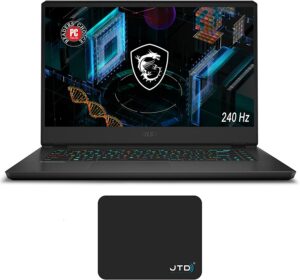
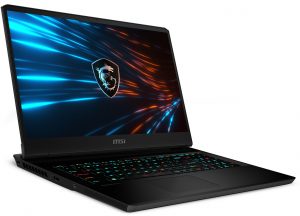
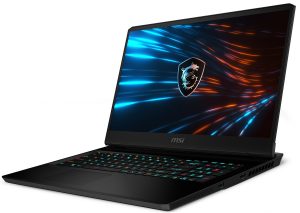
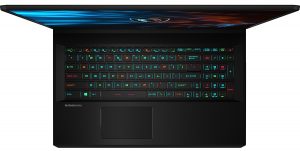
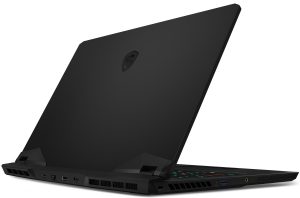
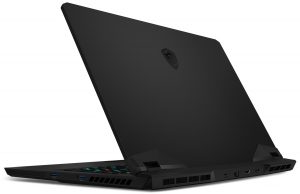
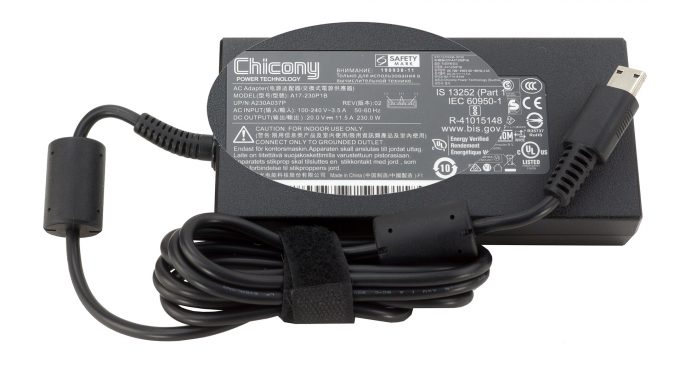
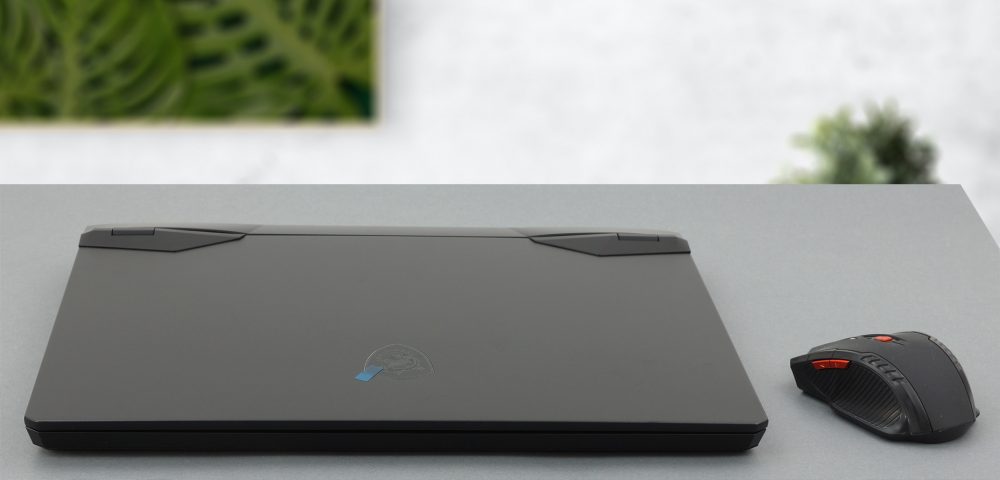
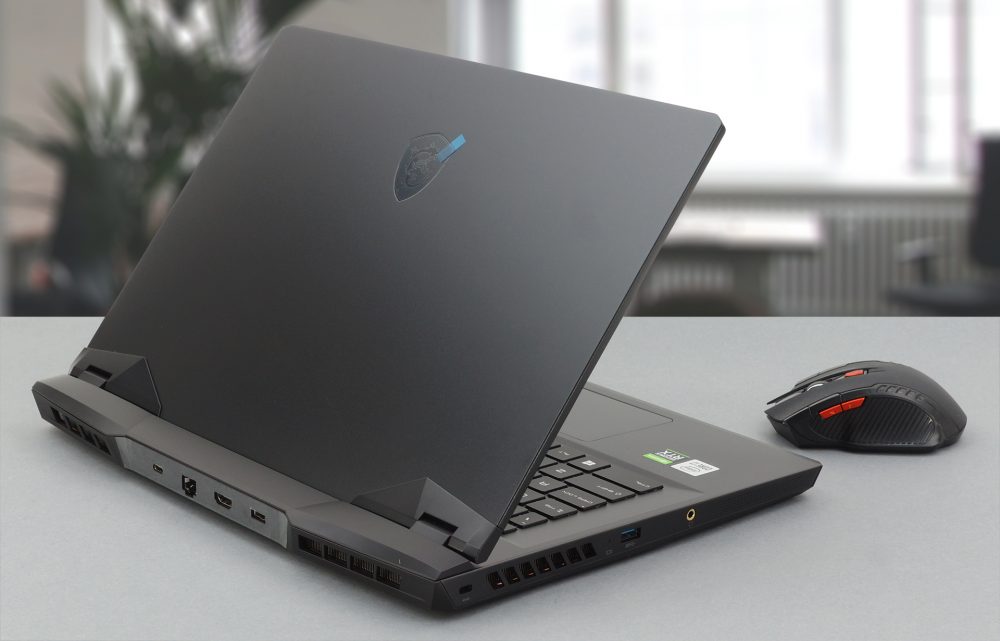

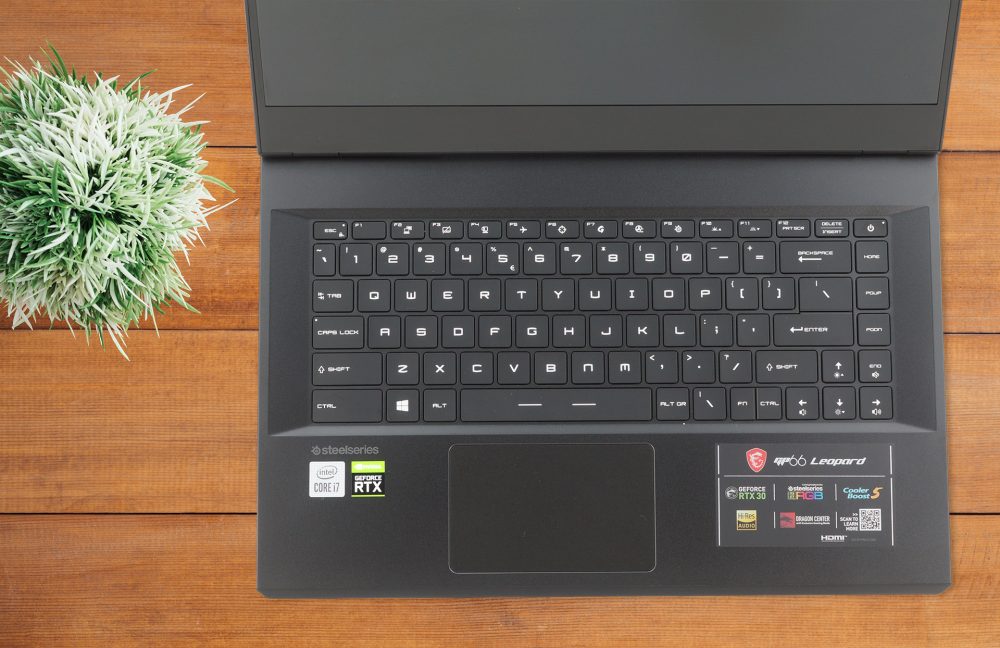
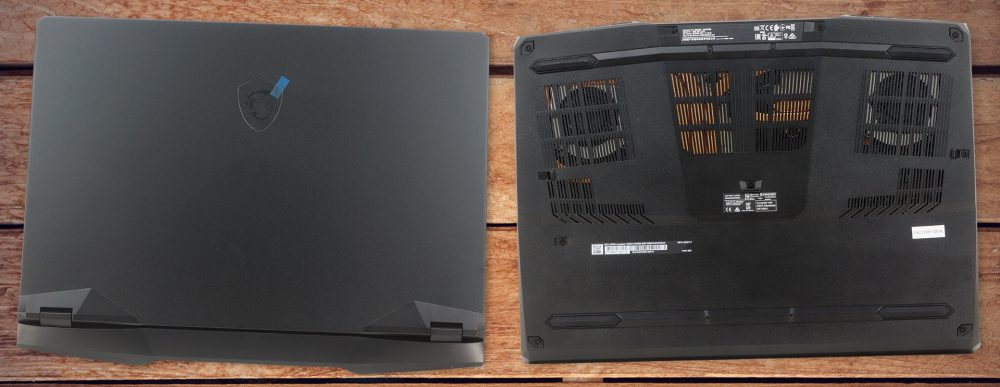
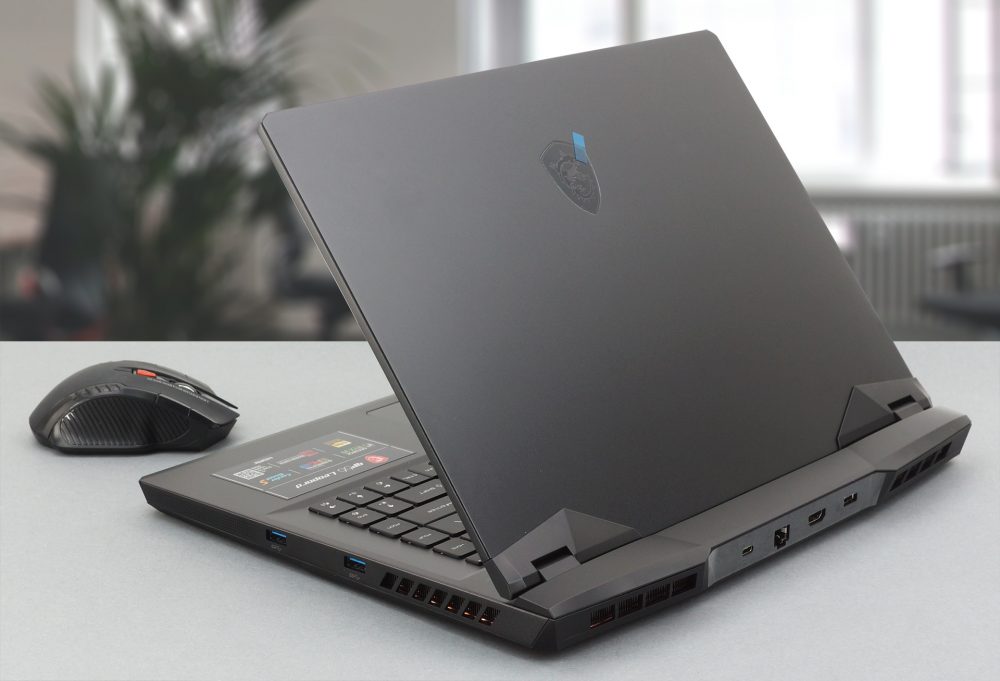



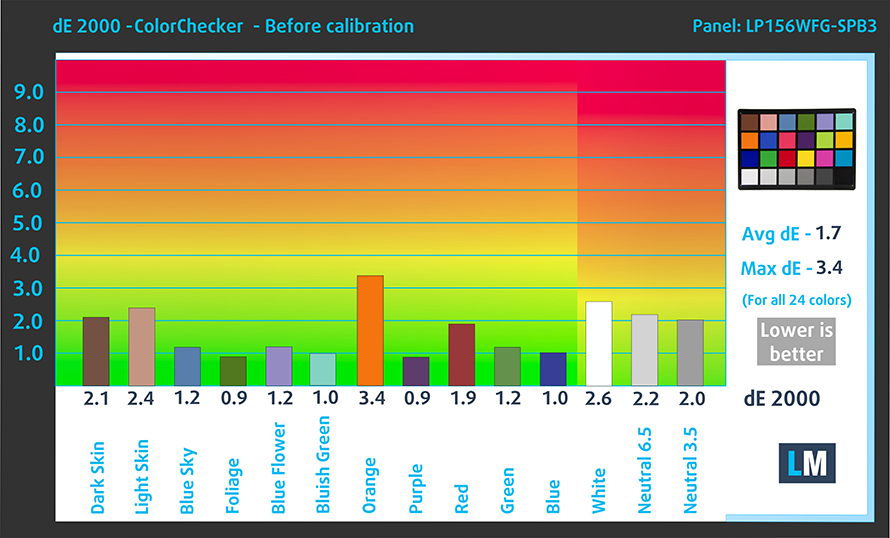


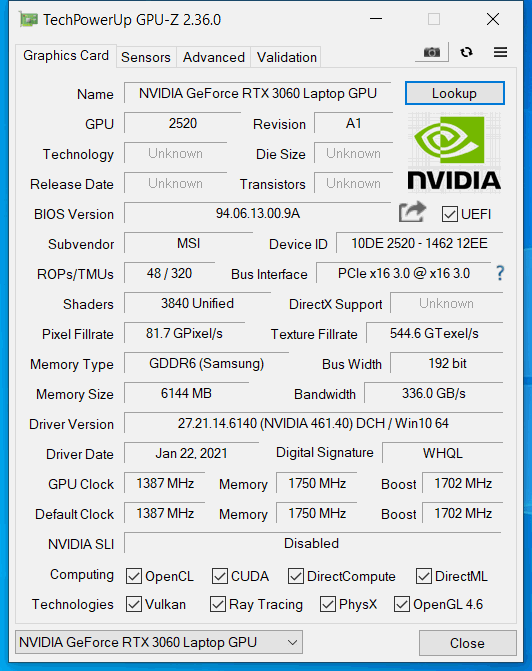








You’re wrong about the RAM, and I find a lot of early reviews get important specs like this wrong, which I why I won’t be subscribing.
The max amount of RAM is 64GB.
succ